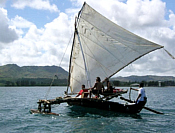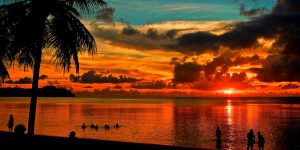
A Carolinian proa or outrigger canoe, sails in Guam’s Apra Harbor.
While I was on Guam last June as a delegate to the Pacific Arts Festival, I was approached about speaking before a meeting of the Guam Chapter of the International Literacy Association (formerly the International Reading Association) on March 11, 2017. I was honored to be invited and look forward to returning to Guam, which was my home for eleven years and to where I have returned each of the eight years since I retired and moved to Virginia to be closer to my grandchildren.
Each time I return to Guam, I have spent time in the local schools working with students of all ages on such literacy skills as reading, writing, and listening comprehension. During my thirty-two year career as a school-based speech-language pathologist, my main interest was in helping children with language processing disorders and these disorders, of course, impact reading and writing development.
When asked by the Guam ILA committee what the topics of my presentation will concern, I was reminded that I needed to address the needs of professionals who work with both younger, early elementary children and those who teach middle school and high school students. To that end, I have been developing a program that will consider the huge complexities of language acquisition and how the human brain has developed to handle those complexities. It is fascinating to look into such linguistic notions such as generative language and deep structure to get a better understand of what a student faces when they set about learning to speak and to read and write. The end goal, of course, is that this improved understanding of this complex process will lead to improved ways to help not only those who struggle with language, but to ease the way for those typically-developing students who are just setting out on the journey toward literacy.
But that’s not all. For ten of those eleven years I lived on Guam, my wife and I lived aboard a sailboat and explored the coast of Guam and the islands of Commonwealth of the Northern Marianas. Since then I have also sailed from Guam to the Philippines and explored the waters and islands of the Philippine archipelago. While engaged in such adventures, I studied traditional canoe building and the secrets of the ancient Pacific navigators at the knee of Manny Sikau, a master navigator from Polowat Atoll.
For nearly forty years I have been writing–short stories, novels and, for two memorable years, essays for a now-defunct online literary journal. And so it was a natural next step for me, once I had a basic knowledge of star-path navigation and had lived among the people of the islands, to write a novel about it all. The result was Brothers of the Fire Star, the story of two boys of different races and cultures who must learn to live together and master the secrets of navigation if they are to survive World War II in the Pacific.
So the next part of my ILA presentation will be to present this book to them, to read from it, and to explore ways a novel that is set on Guam and in the nearby islands and concern island history and culture, can be used to develop literacy.

